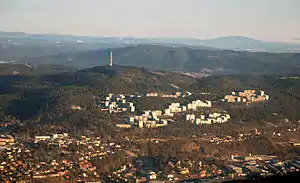Romsås
Romsås is a neighborhood in the city of Oslo, Norway. Located northeast of Groruddalen, at the edge of Lillomarka, Romsås was formerly its own borough but was merged into the larger borough of Grorud on January 1, 2004. The name Romsås originated with the Romsås farm which by 1850 was one of the biggest farms in Østre Aker.


History
With the expansion of Oslo after the Second World War, Oslo kommune granted OBOS a permit to build a new borough in 1967. Construction started in 1969. The borough was formally established in 1973.[1][2]
Subdivisions
Romsås is divided into six borettslag named after local geographical features: Orremyr, Emanuelfjell, Svarttjern, Røverkollen, Ravnkollen, and Tiurleiken. There are also six kindergartens, two elementary schools, a middle school, an assisted living facility (Romsåslia), and a center (Romsås senter) with social housing, a retirement home, shops and services, and a swimming pool. A subway station is located under the center, 50 m below ground level.[3][1]
With the exception of Romsåslia and the church, all buildings are located on the inside of a single road which starts at Grorud and loops back on itself in the shape of an elongated “q”.
Romsås Church
Romsås Church (Romsås kirke) is a 220-seat brick church designed in a postmodern style by architect Arne E. Sæther, with an altarpiece by Nina Sundbye. It was built on the ruins of an earlier wooden structure which burned down in 1986, and was inaugurated in 1995. As the site was formerly a landfill, the church has suffered significant subsidence damage since its construction.[4][5]
References
- "Romsås (strøk)". Lokalhistoriewiki (in Norwegian). Norsk lokalhistorisk institutt. Retrieved March 27, 2019.
- "Oslos bydeler". Lokalhistoriewiki (in Norwegian). Norsk lokalhistorisk institutt. Retrieved March 27, 2019.
- "Historie" (in Norwegian). Romsås vaktmestersentral. Retrieved March 27, 2019.
- "Romsås kirke". Kirkesøk – Kirkebyggdatabasen (in Norwegian). Den norske kirke. Retrieved March 27, 2019.
- "Romsås kirke". Norske kirkebygg (in Norwegian). Archived from the original on October 19, 2014. Retrieved March 27, 2019.
